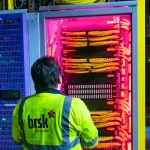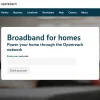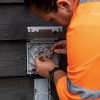4th Utility Survey Finds Confusion Over UK Broadband Terminology

Network builder and ISP 4th Utility, which is deploying a gigabit speed Fibre-to-the-Premises (FTTP) network to UK homes and large residential buildings, has today published the results from a new survey of 2,000 people that found a “major” lack of understanding amongst consumers of crucial broadband terms.
The “Great British Broadband Survey” found that only 1 in 5 UK residents know what “full fibre” means, which they claim is “despite the fact it’s already being used by most households“. But according to Ofcom, at present only 28% of those able to get a full fibre network have actually adopted the service, so this statement isn’t quite correct (they’ve perhaps confused coverage with take-up).
In fact, the broadband bewilderment stretches further. Even when told the exact meaning of full-fibre, some 20% of respondents still weren’t sure if they had it or not. Some 45% said they did have it, with the remainder saying they didn’t.
Advertisement
The survey also found a “considerable lack of understanding about crucial terms” – not only full-fibre, but words such as bandwidth, FTTP – and what is meant by ‘superfast’ and ‘ultrafast’ internet. Even fewer (9%) knew the meaning of terms such as bandwidth or Internet of Things (8%).
Summary of Key Survey Highlights
➤ A broadband outage (12%) ranks below a boiler breakdown (30%), water leak (23%) and total blackout (13%) as the household utility nightmare Brits fear the most.
➤ One in five respondents reported experiencing problems with slow internet at least three times a month. One in three said those problems happen up to twice a month. It’s a cause of friction in many households, with 51% of respondents reporting they argue about slow Wi-Fi, with those heated discussions hitting three in ten of us a few times a month or more.
➤ Almost half of respondents shell out over £30 a month for their broadband, with the bill for around one in ten coming in at £50+. On average, it found that Brits pay £33.52 a month.
➤ Over 50% of respondents experienced issues with their broadband speeds, and 14% said those issues are weekly. But correctly identifying the cause can be a challenge, and 7% of respondents even said not turning off their router at night was the culprit.
In fairness, consumer confusion over broadband terminology and acronyms is not a new problem, and it isn’t helped by the fact that governments and regulators frequently change their definitions. For example, in the UK “superfast broadband” used to mean download speeds of 24Mbps or faster, but this was later revised to 30Mbps+ to match the EU and these days it’s becoming increasingly tedious to think of either speed as being truly “superfast“.
Likewise, much of the industry tends to think of 100Mbps+ as being the start of “ultrafast” performance, but Ofcom rather oddly decided to define it as 300Mbps+. Little wonder that most people prefer to just look at the advertised service speeds of a package to help them understand its performance (i.e. you don’t strictly need to know the jargon, you just want the service to work and work at the speed promised).
Speaking of which, Ofcom recently finalised new guidelines (here) that will effectively only allow broadband ISPs to use terms like “fibre” and “full-fibre” if their network brings fibre optic cables all the way to your home (FTTP/B), which should help to end over a decade of terminology abuse (e.g. ISPs describing slower hybrid-fibre connections like FTTC as being “fibre broadband“). But this won’t be introduced until later in 2024.
Advertisement
Mark is a professional technology writer, IT consultant and computer engineer from Dorset (England), he also founded ISPreview in 1999 and enjoys analysing the latest telecoms and broadband developments. Find me on X (Twitter), Mastodon, Facebook, BlueSky, Threads.net and Linkedin.
« Virgin Media O2 UK and Hubbub Hand Out More Computers to Charities






















































It really is confusing. Just found some interpret FTTC as ‘fibre to the curb’. Which, if it were a thing, should be FTTK in the UK!
And the distinction between FTTP and FTTB is also somewhat less than super-clear. Indeed it might make sense for some properties but the added confusion of two terms, especially ones which are phonetically so similar, is questionable.
I’m sure someone will invent FTTV to make it even worse.
Fibre to the vehicle. 🙂
Fibre to the verge.
Fibre to the village.
Fibre to the vocal.
Well it’s someone’s curb, if you stretch things far enough FTTN (Fibre to the Node) could technically include ADSL
Maybe they do mean, to the curb, as in “limited or restrained” internet.
Therefore, we need FTTCNTTK, Fibre To The Cabinet Next To The Kerb to be truly descriptive.
I wonder if just saying what you have “Old technology” and we can supply you with “The latest technology” would work for the marketeers. No confusing terms or acronyms.
My money is on customer indifference rather than customer confusion.
Indeed and a reasonable point of view. As long as it serves their needs and wants at a cost they consider acceptable customers shouldn’t be any more bothered by the details of their Internet connection than they are how their electricity supply reaches them unless they want to be.
@XGS
100% Correct.
Looking on our street it’s taken Openreach 2 1/2 years to get near 50% take up (29/61 properties) despite the fact they’ve no competition until about 2 months ago. Mind you so far they’ve not got 1 connection (The Swish rep was knocking doors the other day). Apart from the geeks like me I suspect most of the take up has been when people have been renewing contracts.
All of this was caused by the ASA years ago when it wrongly declared VM Coax and/or BT’s VDSL as “fibre”, instead of doing its job. To this very day, BT is misleading consumers here, see e.g. https://www.bt.com/broadband/deals
Their naming convention is confusing.
IMHO, I would name them like this:
All speeds up to 150mbit/s should be named basic or standard
All speeds between 150mbit/s and 500mbit/s should be named fast
All speeds above 500mbit/s should be named superfast
All speeds above 1gbit/s should be named ultra-fast
Also, only if the connection has optical fibre from ISP to home (FFTP) that’s the only time it should be called fibre, all other names are confusing.
There is a similar story with 5G NSA on mobile, that should not be called 5G as it isn’t, but that’s for another topic.
The only problem with that is that already some providers are selling speeds of 2, 5 and 10Gbps. How are those to be classified?
I am struggling with an FTTC connection that varies between 10 and 15Mbps down and about 1.2Mbps up with one neighbour 50 yards away getting 23Mbps down, all because part of my line to the cabinet is aluminium, not copper.
Why shouldn’t 5G be called 5G? NSA uses many key elements of the 5G NR system including the radio technology, just not all of them.
That’s not the same scenario as when the Americans rebranded 3G HSPA as “4G” and then rebranded LTE as “5G evolution”.
Why not just use the numbers?
If only the government regulator and advertising standards hadn’t allowed people to call a copper cable “fibre”. I put 100% of the blame on to them. We are the only country in the world that calls copper “fibre”. It was designed to confuse and irritate laymen. It worked. When we tried canvassing the area to get openreach to do a community fibre build, 9 out of 10 people said “I’ve already got fibre” (They didn’t of course).
This comes down to the fact that the general pubic are thick morons. Simple.
People on this forum will not understand unless you have to deal with the pubic and I can tell you they are worse now than ever when it comes to knowledge about anything especially technology, and don’t think the younger generations know anything either. They are just as bad as not knowing the basics (sending an email, printing a document, typing something using a traditional keyboard).
that’s the average person. And 50% are even thicker.
Bitter old man, much?
It’s very easy to dismiss the general public’s ignorance about one’s own field of expertise. I dread to think what a doctor would make of my half-baked theories about the human body.
Human knowledge is too diverse for everybody to be expert in everything.
Okay, for one, I’m apart of the “younger generation” (gen z) and I know all of those things, it’s probably because i actually look for these things properly and genuinely know compared to some others. It may or may have not also been because I was homeschooled for many years after the fallout of the school system (partly because I was bullied by everyone imaginable) did have a few friends of the ones who didn’t and the fact my sibling was planning to hit the head teacher… Which I guess doesn’t count me as being the “general public” instead,I’m an exclusive person that knows how most things go typically.
Actually that’s certainly true. I actually think the younger generation are worse with tech, despite being obsessed with it – because they’ve grown up in a touchscreen world, and never had to learn the nuts and bolts. We had to, back in the day, because there was no other way. Some would call it progress – i.e., we can all use and enjoy tech without having to understand it at a low level; but obviously as geeks, we would probably disagree!
Public ignorance is the key to keeping the establishment in power. Therefore the public is kept in it’s ignorance. Education has been dumbed down so kids are only being taught what the powers that be want them to know.
The terms are all pretty much meaningless. “Superfast” goes from not even an acceptable level of service to OK – at least on the download side – they don’t describe upload speed at all. IMO, they should just get rid of all of these terms and advertise download and upload speeds with a standardised description of what the package is suitable for.
> think of 100Mbps+ as being the start of “ultrafast” performance, but Ofcom rather oddly decided to define it as 300Mbps+
Perhaps this was done in order to exclude G.Fast.
Here’s some points I have:
Just name it based on the standard used to deliver the service i.e. VDSL, G-PON, XGS-PON etc. The terms ‘superfast’ & ‘ultrafast’ are marketing fluff.
Do away with the word ‘speed’ – misleading term.
Don’t associate WiFi with the internet connection unless you are selling some degree of WiFi service such as a mesh network.
Oh, don’t get me started! As the tech support go-to for the entire family / neighbourhood / town, that’s always the first complaint. “The Wi-Fi is slow!” – erm, do you actually mean the Wi-Fi? I’ll come over with an ethernet cable and tell you where the real problem is….
Although, as gigabit connections proliferate (no such luck for me – I’m in a fibre desert), the Wi-Fi will actually become the limiting factor, technically. But I could certainly make a career out of going around, ripping out people’s canned routers and putting in proper distributed systems, such as POE access points and cameras, or just a decent tri-band mesh system.
Another thing that BT is entirely responsible for. FTTC was actively marketed as “fibre optic broadband”.
https://youtu.be/XvlnJvb-HaE?si=KIod-eKpEYes7Npu
Scroll to 20 seconds.
And don’t even get me started on infantile nonsense such as “superfast”, “ultrafast” and so on. Why not just use numbers?
apologies for derailing your BT bashing session, but it was Virgin that started the “fibre optic” stuff.
eg. https://informitv.com/2008/02/06/virgin-media-cleared-over-misleading-broadband-claims/
….and an awful lot of people confuse their home wifi speed with their broadband speed
For example, in the UK “superfast broadband” used to mean download speeds of 24Mbps or faster, but this was later revised to 30Mbps+ to match the EU and these days it’s becoming increasingly tedious to think of either speed as being truly “superfast“.
Using Openreach’s availability checker for my address I get:
Standard Broadband “Up to 24 Mbs downloads speed, Up to 1 Mbs upload speed”
Superfast Fibre (sic) Broadband “11-19 Mbs downloads speed, 0-1 Mbs upload speed”
I wonder why consumers show confusion. Fortunately I have an Alternative Network supplier who has installed an Optical Fibre connection giving up to 900 Mbs. My home network, using Ethernet and as well as a Wireless Access Point means that I can avoid blaming the ISP for poor WiFi.
It all started when they were allowed to call FTTC Fibre so they will now struggle to inform consumers of the difference between FTTC and FTTH and then you get Superfast. Ultrafast and anything else in-between. It is just total confusion